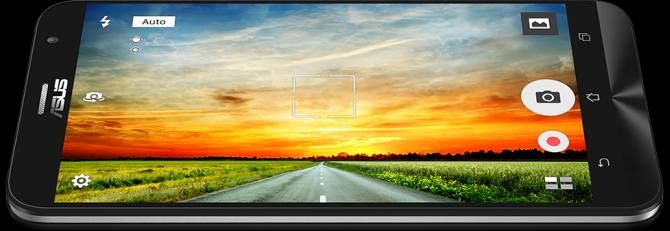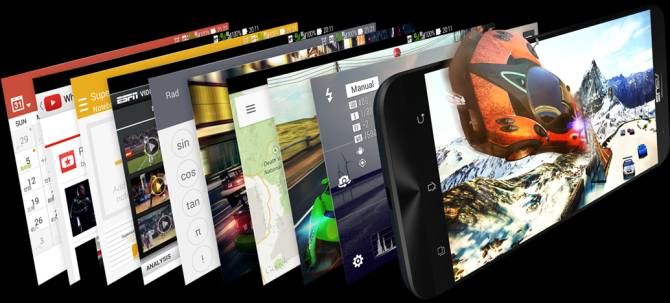The camera performance disappoints hugely and going by other specs, it won't be a surprise if Asus brings in quick price cuts to garner some extra attention, says Himanshu Juneja

Photograph: Courtesy, asus.com
When Asus made its foray into the mobile phone market, mot many thought much about the move. But by bringing competitively priced phones, Asus Zenfone series not only found buyers, but garnered high praise for products which left little to complain about.
It's 2015, and Asus is yet again ready with its new phones which can shake up industry. The company seems to be ambitious by ringing up not one or two, but four variants of its latest Asus Zenfone 2.
But do these new phones hold enough firepower to take the company's stakes to new heights? Time for a close look at the ZE551ML variant of the ZenFone 2 series.
Build

Make no mistake, the Zenfone 2 is pretty much a solid member of the phablet category. The phone measures 152.5 x 77.2 x 10.9 mm and at 170 gms, its weight isn't any less either.
The phone clearly looks like an upgrade of Zenfone 5 in terms of appearance. The phone's plastic back panel has been imparted a brushed metal look. The phone also carries the 'chin' with more subtly laid out concentric circles.
The 3.5 mm headphone jack and the volume buton are located on the top. The latter is bang in the middle of the edge, and this makes it quite a task to reach out. The phone comes with double tap to lock/unlock feature, but is bit of a hit and a miss at times.
The micro USB port is located at the bottom, and the volume rocker, taking inspiration from the LG phones, is positioned at the back. The volume buttons carry textured finish.
There is a mono speaker provided on the rear side as well.
Overall, the phone felt premium when held, but the sheer size of the device doesn't go unnoticed.
Display

The phone carries an IPS screen measuring 5.5 inch. It is a Full HD screen with a resolution of 1080 x 1920. This results into a high pixel density of 403 ppi.
Despite the impressive numbers, the display is let down by its lack of brightness levels. The screen falls short on this regard, and hence the outdoor visibility takes a hit as well.
The display otherwise produces crisp and natural looking colours. Users can adjust the display mode to their taste. Viewing angles of the screen were pretty good.
Screen has been provided some protection with Gorilla Glass 3 technology.
Hardware
Asus Zenfone 2 is powered by an Intel chipset under the hood. The phone comprises of Intel quad-core 2.3 GHz Atom Z3580 processor. There is the PowerVR G6430 graphics chip, and the trend setting 4GB of RAM as well.
The phone comes with 32 GB of onboard memory, out of which near about 22 GB is available for the users. The phone supports microSD cards upto 64GB.
Connectivity

The phone supports plethora of connectivity options, like 2G, 3G as well as 4G, but the second SIM has been restricted to offers only 2G support.
Other connectivity feature for the phone are Bluetooth 4.0, Wi-Fi, Wi-Fi Direct, A-GPS, GLONASS, and NFC.
The phone seems to be well stacked up with features in this department, but the second SIM being only 2G should have been avoided.
Software

The phone sports Android's Lollipop (ver 5.0), having Asus' Zen UI slapped on top of it. Just like the Zenfone 5, the UI also seems to have been given a good update.
The lockscreen greets with weather and time widget, as well as three shortcuts. These three can be customised according to user preferences.
The Zen UI gives good room for customisation to the user, allowing for a change of icons, themes and even the homepage animation. The user gets to rearrange the homescreen as well.
One handed operation feature gets a much needed tweak of user preferred screen compactness size.
The UI has provision for guest, basic, as well as kids access mode. There is also option to double tap to wake the screen, and ZenMotion allows drawing of gestures on locked screen to activate apps. Goodies also include setting of password on apps to restrict access.
The smart grouping functionality helps in bundling similar apps into folder, allowing for ease of access.
As mentioned earlier, the bloatware on the phone isn't negligible. With 10GB worth of apps pre-installed, not making them removable is another raw deal offered here. Thankfully, the user can disable them.
Another worthy mention is the option to pin a particular app to the homescreen to work with, but user needs to exit the app to do anything else apart from that app.
Performance

Even though the phone is powered by an Intel chipset, the phone passes the tests with flying colours.
The phone handled the tasks thrown at it with consummate ease and impressed with its consistent performance. During the testing, the phone handled multiple apps which were being run simultaneously without any hiccups. There were no lags with transition effects, opening or closing of the apps either.
The HD content of games and movies played out without any lag or noticeable frame drops.
The rear speaker gives decent output, but cannot handle higher volumes. A front-firing stereo setup would have been much more preferred.
Camera

The Zenfone 2 has a 13 MP rear camera, with dual-LED (dual tone) flash as its primary snapper, it also is carrying a 5 Megapixel front facing camera.
Anybody who has experienced the Zenfone 5's camera, will agree that Asus hasn't been able to carry the trend forward. While the ZE551ML's camera is capable of capturing impressive pictures, it is equally capable of throwing in bad surprises as well.
The pics taken in naturally well lit conditions looked very impressive, but the photographs when zoomed in revealed sketchy details. There were lots of instances revealing over exposure. The presence of noise raised eyebrows since a camera with 13 MP camera shouldn't be yielding such aberrations. Overall, the camera performance was definitely below par, and disappointed hugely.
The macro shots were very impressive though.
Photographs taken during low light settings turned out to be grainy and had presence of noise. A nifty feature however comes to the phone's rescue here by restricting the camera's prowess to 3 Megapixels only. This works nicely as the details are captured efficiently without any hint of trying too much and messing up the final results in post processing.
The front facing camera does a very decent job of capturing the selfie shots. Beauty feature proves useful here.
Battery

The phone carries a mammoth non-removable Li-Po 3000 mAh battery, and enables the phone to remain powered up for about day and few more hours.
The usage pattern during the testing phase was moderate to heavy, and surely enough, the phone was taken through the tasks of mobile gaming, talktime hours and some casual net browsing.

It maybe possible that Asus' choice of Intel chipset is not allowing it to harness the full potential of a huge battery.
The phone does provide power saving mode to extract those crucial juice during crunch times.
Verdict
The Zenfone 2 ZE551ML comes across as a pretty decent option, which has most of the things in the correct place. If one keeps the camera performance aside, the Zenfone 2 ZE551ML can be termed as a step in the right direction when compared with the Zenfone 5, but the scene has changed in the past few days.
The ZE551ML has 3 variations. ZE551ML with 4GB RAM, and 64GB memory costs Rs 22999.
The ZE551ML with 4GB RAM, and 32 GB onboard memory is priced at Rs 19999.
And ZE551ML with 2GB RAM, and 16 GB onboard memory will set the buyer back by Rs 14999. All these three variants come with 5-5-inch ful HD screen.
While having 4GB RAM with dual SIM will be quite a plus for its chances to survive, it seems like that these phones will be competing with Xiaomi Mi4, and One Plus One primarily. Throw in Samsung Galaxy Note 3 Neo, HTC's 820 and the arrival of Mi4i from Xiaomi, all this isn't very good news for Asus's phone, whose 13 MP camera has failed to deliver.
Going by the specs, it won't be a surprise if Asus brings in quick price cuts or some special offers to boost its chances and prevent ZE551 ML to garner some extra attention.









